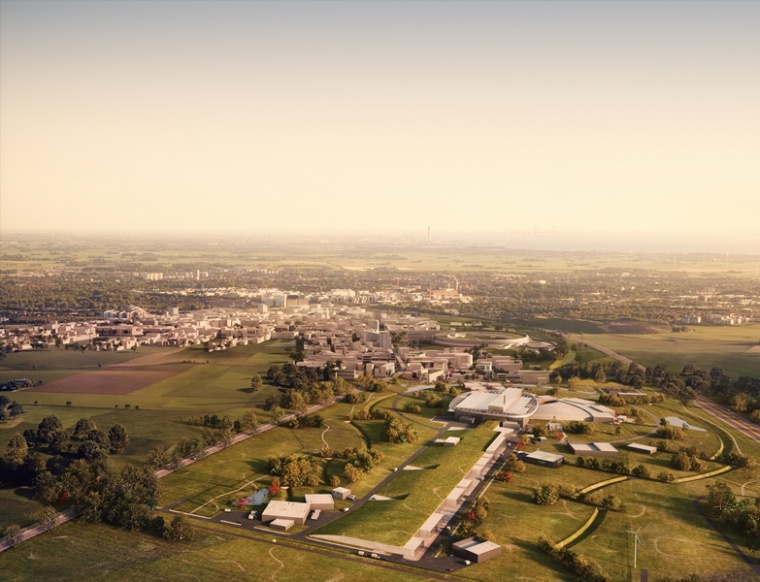European Spallation Source: Bridging the innovation gap

The European Spallation Source (ESS), one of the world’s largest materials science hubs, is currently being built on the outskirts of Lund. In an interview with NIB Newsletter, ESS Director General John Womersley discusses the contribution of intergovernmental “big science” to innovation and industrial growth.
The European Spallation Source is a multi-disciplinary centre for materials science research, and is based on what will be the world’s most powerful neutron source. Together with the neighbouring MAX IV synchrotron light laboratory, the facility will form one of the largest science hubs in Europe, equal in size and relevance to CERN and ESO.
The construction of ESS is co-financed with a EUR 100 million cash facility from NIB. Once ESS initiates its user programme in 2023, the neturon source will offer new research opportunities in fields of life sciences, energy, environmental technology and chemical products for up to 3,000 researchers a year in the Nordic–Baltic region and globally.
“Big science” centres such as this are an asset to the European research community, but they often have difficulties connecting their scientific work to the needs of the industry, and are perceived as failing to drive innovation.
The discovery of the Higgs boson at CERN is an often-cited example of a poorly understood scientific advance with little practical application. However, as ESS Director General Prof. Womersley points out, the world wide web was was also invented at CERN as a direct result of the research conducted there.
“There has been a lot of discussion in the past few years about the need for a materials science hub of this size in Europe, and how to best derive commercial value from it”, says Prof. Womersley.
“Europe has a very good track record of scientific excellence”, Prof. Womersley points out. “Our universities educate qualified scientists who produce high-impact research, but I believe we all have the gut feeling that we are not as good at relating this academic work to real-life problems and to industrial competitiveness.”
Part of the problem is the perceived lack of access for industrial users to large research infrastructures, and miscommunication between actors. Research facilities and industry do not always seem to rally behind common goals.

“In my view, this reflects the prevailing culture of all actors: academics, industry and government. The European academic culture often appreas to emphasise scientific output as somehow distinct from the needs of business. This silo thinking has to be addressed, and I hope ESS can be part of the change.”
Prof. John Womersley
Director General of the European Spallation Source (ESS)
ESS is a European Research Infrastructure Consortium (ERIC), a multi-disciplinary research facility based on the world’s most powerful neutron source.

From left: Jan Vapaavuori, EIB; John Womersley, ESS; Henrik Normann, NIB; and Per Åkerlind, SEK.
Science for industry and society
Closing the gap between science and industry and capitalising on the potential of “big science” infrastructures to generate growth would mean a global competitive advantage. The case for new strategic structures to take industry cooperation to a higher level is a strong one.
“A recent survey of neutron sources revealed that industry directly uses 5% of neutron scattering beam time available in Europe, and that an additional 8% is used for collaborative research carried out jointly by academia and industry”, says Prof. Womersley. “There is clearly potential for significant growth beyond this.”
The ESS research programme that starts in 2023 will give both small and large companies access to the facility.
“ESS is currently carrying out quantitative studies to better understand the needs and expectations of industrial users and exploring various modes of industrial access to best serve future users”, he explains. “We are considering different options: direct access, collaborative access via universities, and access facilitated by actors such as research institutes.”
“We are already involved in initiatives aimed at capacity building among industry through various programmes, like SINE2020 and Baltic Tram, which offer industrial users free access to beam time in order to carry out feasibility studies and other measurements.”

Illustration: European Spallation Source.
A European effort
Companies almost never innovate in isolation. ESS is making a clear effort to highlight the practical contribution in linking “big science” to the advancement of the competitiveness of European industry.
“The cooperation between science and industry at ESS is already relevant to the issues we are dealing with in energy, life sciences and healthcare. We are hoping to address these challenges scientifically, but also societally, so we can keep up with other regions, and solve the problems we are facing globally.”
It is hoped that the collaboration efforts at ESS will bring together smaller companies that would ideally settle in the Lund-Copenhagen region.
ESS also aim to strengthen the cooperation with Lund university and other universities in the region.
“I believe what we are trying to do here at ESS has an idealistic side to it. We are effectively demonstrating that scientific collaboration between academic institutions, governments and industrial users can work. It goes beyond simply building a new facility that advances science; the project is crucial for Europe’s competitiveness in a knowledge-based economy.”

